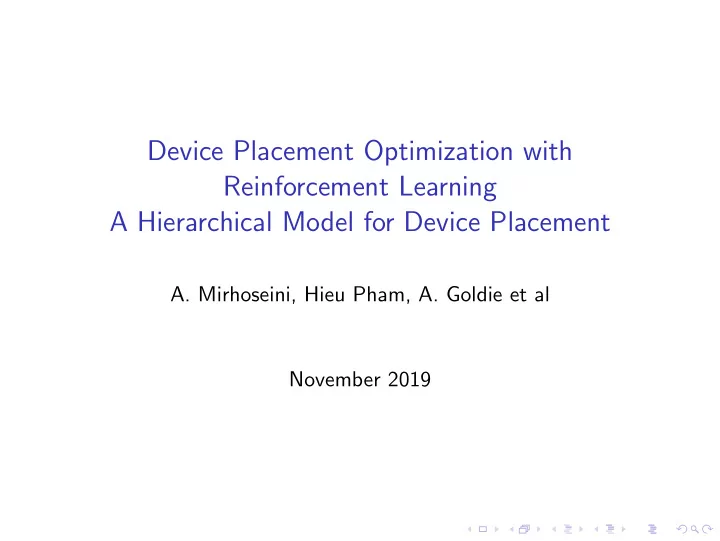

Device Placement Optimization with Reinforcement Learning A Hierarchical Model for Device Placement A. Mirhoseini, Hieu Pham, A. Goldie et al November 2019
Problem Background ◮ Tensorflow allows user to place operators on different devices to take advantage of parallelism and heterogeneity ◮ Current solution: human experts use heuristics to place the operators as best they can ◮ Some simple graph-based automated approaches (e.g. Scotch) perform worse
Approach ◮ Use reinforcement learning and neural nets to find the best placement
Background: RNNs ◮ RNNs model dependencies between data; they have persistence ◮ E.g. previous words or previous placements of operators
Background: LSTM and the Vanishing Gradient Problem ◮ Too many multiplications means gradient quickly diminishes to 0 ◮ Gated structure can model long term dependencies better ◮ Forget, input and output gates control a hidden state
Background: Reinforcement Learning ◮ Traditional use of NNs is in a supervised setting with labelled training data ◮ Need to learn from the environment ◮ Want to maximise the expected reward: J ( θ ) = � τ P ( τ ; θ ) R ( τ ) ◮ The derivative, ∇ θ J ( θ ) is equivalent to � τ P ( τ ; θ ) ∇ θ log ( P ( τ ; θ ) R ( τ ) ◮ This is actually an expected value, so can use monte-carlo sampling to approximate: � K ∇ θ J ( θ ) ≈ 1 i =1 R ( x i ) ∇ θ log ( P ( x i | θ )) K
Implementation: Neural network architecture ◮ Sequence-to-sequence model; this is two RNNs that communicate via shared state ◮ Input: sequence of vectors representing the type of each operation, output sizes, encoding of links with other operators ◮ Output: placements for operations
Implementation: RL ◮ Uses monte-carlo sampling as discussed ◮ Reward function is the square-root of running time ◮ High fixed cost for OOM on e.g. single GPUs ◮ Subtract a moving average from reward to decrease variance
Grouping ◮ Dataflow graph huge: big search space and vanishing gradient ◮ Solution one: Co-locate operators manually into groups that should be executed on the same device ◮ Solution two: Add another (feed-forward) neural network, the grouper ◮ Hierarchical approach: grouper and placer
Evaluation: Experimental setup ◮ Measure time for single step of several different models: RNNLM, NMT, Inception-V3, ResNet ◮ Run on a single machine, using CPU and 2 - 8 GPUs ◮ Baselines are single CPU, single GPU, using the Scotch library, expert placement
Evaluation: Results ◮ Only 3 hours for hierarchical model ◮ Performance significantly better than the manually co-located version
Evaluation: Understanding the results ◮ Classic tradeoff: distributing more for more parallelism, want to minimise copying costs ◮ Different architectures have different amounts of parallelism available to exploit
Strengths ◮ Hierarchical planner completely end-to-end ◮ Overhead of three hours is small (original paper 13-27 hours) ◮ Capable of finding complex placements which are beyond a human ◮ Sometimes very substantial improvements
Weaknesses ◮ First paper not reproducible: don’t mention the version of Tensorflow, even original authors couldn’t reproduce results ◮ Results mixed; often no improvement if best placement is trivial. Can this be determined by looking at the amount of parallelism in the graph? ◮ Will it scale? NMT 8-layer has a decrease in performance compared to human expert. Why this sudden decline? ◮ How many times did they run the random RL process? ◮ Incorporate humans to improve placements even further
Questions
Recommend
More recommend